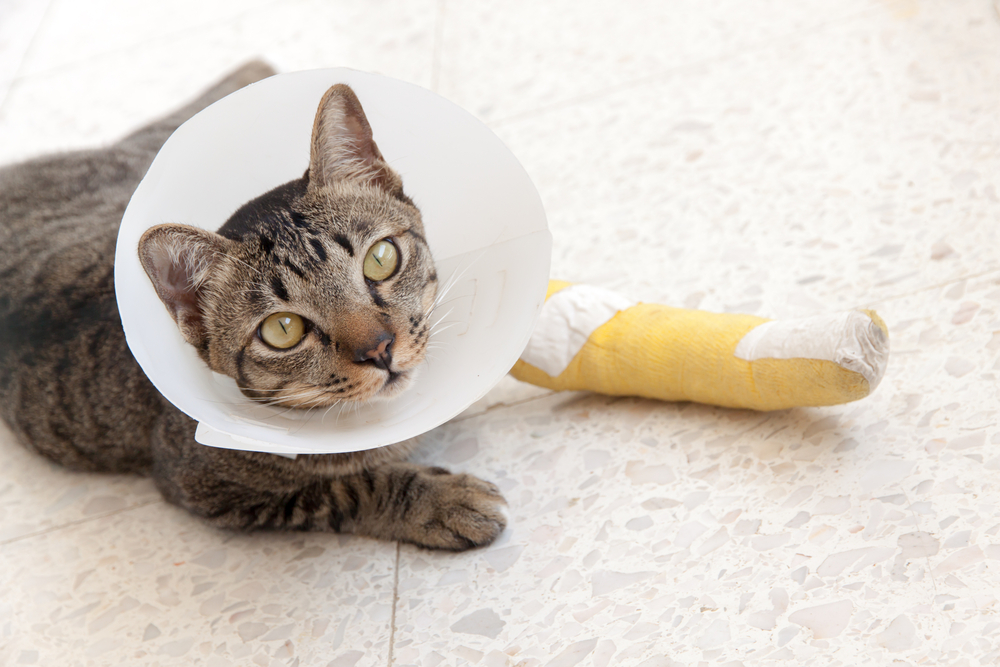The idea of experiencing a pet-related emergency is enough to cause any owner stress and anxiety. But, being prepared for such an unfortunate event with some basic veterinary first aid knowledge and items could save your pet’s life. While you may not be able to address every possible problem, being equipped with a few important skills can help stabilize your pet while you head to Caldwell Animal Hospital or your nearest 24-hour veterinary emergency center for further evaluation. Following are four veterinary first aid scenarios you should know how to manage.
#1: Heatstroke in pets
As we approach the warmer months, our pets become more susceptible to overheating or heatstroke, an emergent condition in which the core body temperature exceeds 104 degrees. Knowing heat exhaustion or stroke signs—increased panting, drooling, exercise intolerance, obviously elevated temperature, rapid heart rate, vomiting, diarrhea, or bright red gums—is crucial, because they can come on rapidly. If your pet is experiencing these signs on a hot day, take their rectal temperature and attempt to slowly cool them down. Bring your pet into a shady or air-conditioned area, and place cool, wet towels over their body, or hose them down, sweeping the cool water over their body. If possible, aim a fan toward your pet to encourage evaporative cooling. Offer your pet cool water to drink. In the meantime, contact Caldwell Animal Hospital for further guidance, and then carefully transport your pet for veterinary care as soon as possible. Do not place alcohol on the foot pads or use extremely cold water to cool your pet, because these measures could actually decrease their ability to dissipate heat, and further add to the problem.
#2: Poison exposure in pets
Most homes, yards, and garages are rife with toxins that our pets may contact. Bleach, antifreeze, rodenticides, and medications all present opportunities for a potentially toxic situation. In general, most products hazardous to humans are also dangerous for pets. If your furry friend is exposed to a harmful substance, first read the product label, which should give directions on action to take if the product gets into people’s eyes, on skin, or is ingested. Generally, you can follow these same guidelines for similar pet exposures. For instance, if the product label says to wash skin thoroughly with soap and water after skin exposure, do so on your pet as soon as possible. Then, contact our hospital and/or the Animal Poison Control Center for further instructions. If you believe your pet has ingested a potentially toxic substance, do not induce vomiting without professional guidance. Of course, if you are uncertain how to handle a toxin exposure, call for help immediately.
#3: Seizures in pets
Seizures are common in pets for a variety of reasons. Signs of an active seizure can include collapse, paddling, thrashing, incontinence, and drooling. Many pets have prodromal signs that are not always obvious to the owner, but may include anxiety, confusion, or irritability. Postictal signs often manifest after a seizure, with affected pets appearing disoriented, confused, or drowsy for a period of time. If your pet is having a seizure, move any potentially dangerous items or furniture away from your pet and block off any stairways. Do not attempt to restrain your pet, but ensure their surroundings are safe. In most cases, you won’t need to intervene during a seizure, but if your pet attempts to vomit, you may need to ensure they don’t choke by gently turning their head to the side. Try to time and record the seizure, and to keep track of any multiple events. Contact our office or head to your veterinary emergency hospital if this is your pet’s first seizure, if more than one seizure occurs in a 24-hour period, or if a seizure lasts more than two to three minutes.
#4: Torn nails in pets

Toenail injuries are common in dogs, whose rough play, digging, or other activities can cause the nail to break or split open, resulting in a painful—and sometimes bloody—situation. While typically not an emergency, broken toenails should be evaluated by a veterinarian as soon as possible to minimize pain and infection risk. In the meantime, you may need to address any bleeding and prevent further nail damage. If the injury site is actively bleeding, apply constant pressure to the area with a gauze pad or other absorbable material until bleeding slows. You can also apply a small amount of styptic powder or cornstarch to the nail to help stop bleeding. While not usually necessary, you can wrap a temporary bandage around your pet’s foot to protect the injured nail while you transport them to the veterinarian. Place a gauze square over the injury and use bandage tape or flexible bandage wrap, taking care not to wrap the limb too tightly. If the bleeding is still not controlled, head to your nearest veterinary emergency hospital right away.
Of course, knowing veterinary first aid will come in handy in numerous other situations. For other potential scenarios, consult the American Veterinary Medical Association’s first aid guide. As always, the Caldwell Animal Hospital veterinary team is here for your pet’s urgent needs. Contact us with any additional questions or concerns.







Leave A Comment